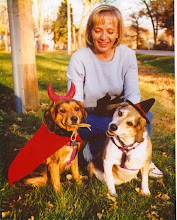Much has been written about canine social structure and how
it relates to dog behavior. The concept
of alpha dominance originally came from studies of wolf packs in the 1940s. The findings of these studies trickled down
to the domestic dog arena and found their way into dog training
techniques. Dominance exercises, such as
the alpha roll, were recommended to prevent aggression and other behavior
problems.
People began to challenge the alpha dominance theory on a
number of fronts. Is wolf behavior
really indicative of that seen in domestic dogs? Were the alpha rolls initiated by the higher
ranking wolf, or were they actually an appeasement ritual offered voluntarily
by the subordinate wolf? Was the wolf
behavior really exhibiting dominance, or does the wolf pack operate on
something closer to a parent/child type of relationship?
The fact is that dogs are not wolves. Breeding of domestic dogs through time has
generally increased their sociability and playfulness while decreasing fear and
aggression, making them less and less like their wild cousins. Additionally, there
is little evidence to suggest that dominance exercises did anything to stem the
development of aggressive behavior.
More recent studies have shown that alpha behavior does not
necessarily mean physically dominant behavior.
True pack leaders do not need to rely on physical aggression to maintain
their positions in the hierarchy. They
have earned the respect of the lesser dogs and need only to exhibit their calm,
confident behavior to keep order within the pack.
My beagle mutt, Tootsie Roll, was one of those natural alpha
dogs. In the 18½ years that she was with
our family, our little dog pack included three other dogs. Through that entire 18½ year period, Tootsie
Roll was always recognized as the pack leader (after the humans, of
course). It always amazed me that this
sweet, loving dog would be the widely accepted leader of the pack. After reading more about pack cultures, I
came to identify in Tootsie Roll, actions that others have attributed to the “natural
alpha dog”; her confident stance, staring down of usurpers, a rare soft growl.
There were occasional challenges to Tootsie’s position. Most often these came from Valentine, our
other beagle mutt. Even in old age,
Tootsie’s calm assertiveness would prevail over Valentine’s feeble attempts to
unseat her, and the social hierarchy never changed. We lost Tootsie Roll two years ago, but I
will never cease to be amazed at the dynamics we saw exhibited in our little
pack while she was with us. To the end,
she maintained her top dog status.














